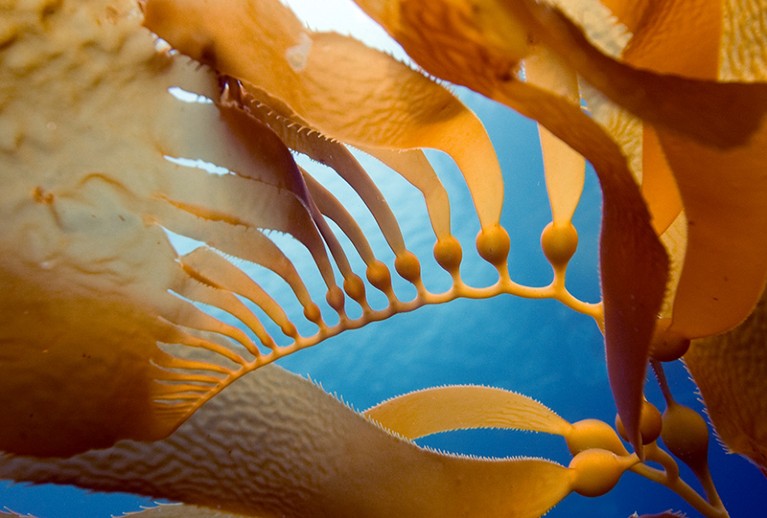
Kelp, a type of brown alga, growing off the coast of California.Credit: Douglas Klug/Getty
Slime: How Algae Created Us, Plague Us, and Just Might Save Us Ruth Kassinger Houghton Mifflin Harcourt (2019)
It rankles when I hear a distinguished molecular biologist declare that this gene or that ‘is conserved throughout eukaryotes, from yeast to humans’. Yeast and humans (plus nematodes, zebrafish and many other organisms) are not representative of all eukaryotes, which have nuclei and membrane-bound organelles in their cells. They belong to one rather restricted evolutionary group, the Opisthokonta (see S. M. Adl et al. J. Eukaryot. Microbiol. 66, 4–119; 2019), and account for a tiny fraction of global biomass (see Y. M. Bar-On et al. Proc. Natl Acad. Sci. USA 115, 6506–6511; 2018).
So it is a real pleasure to see Slime (sold as Bloom in some territories), a book devoted to algae: the often-neglected eukaryotes and prokaryotes (organisms without nuclei or discrete organelles) that are of immense biological importance, yet only distantly related to yeast and humans.
Science writer Ruth Kassinger, who specializes in botany, covers the entire range of algae. They include blue-green algae (the oxygen-producing, photosynthetic cyanobacteria), red and green algae (close relatives of land plants), and distantly related groups such as diatoms, coccolithophores (responsible for chalk deposits such as the White Cliffs of Dover), dinoflagellates and kelp. Kassinger rightly describes algae as “the most powerful organisms on the planet” — not least for the amount of carbon dioxide they ‘fix’, or turn into organic matter. She sets out to educate us on their importance and compelling interest.
Slime has four parts. One concerns evolution, including how algae determined the growth of Earth’s atmosphere. The second is on algae as food. The third covers cultivation for uses from sports shoes to fuel. And the last looks at human impacts, from coral bleaching to eutrophication, and how algae might redress the effects. There is also a fascinating appendix of recipes using algae. (I’m eagerly awaiting delivery of ‘Irish moss’, the red alga Chondrus crispus, to make blancmange.)
The smallest algae are single-celled prokaryotes less than a micrometre across, such as the oceanic Prochlorococcus, a major player in CO2 fixation. Others range from unicellular eukaryotes to multicellular seaweeds many metres long. They grow in environments from polar snow to hot springs.
Some have lost the ability to photosynthesize and now live as parasites. The most notorious is Plasmodium, arguably the most dangerous alga in the world, which retains a remnant, non-photosynthetic chloroplast and is the cause of malaria.
In spite of having studied algae for more than 30 years, I learnt much from Slime. I knew of the distinguished British phycologist Kathleen Drew-Baker, who 70 years ago discovered the life cycle of Porphyra, an alga used to make the dietary staple nori in Japan. But I didn’t know that her work solved the mystery of why the nori harvest frequently failed in the years after the Second World War (all to do with typhoons and exploding mines); nor that there is a monument to her in Japan, where prayers are said every year on her birthday to honour her memory.
And I hadn’t really thought about who gave nineteenth-century microbiologist Robert Koch the idea of using agar, derived from a red alga, as a growth medium for bacteria. (Attempts to use gelatine failed because it melted at the temperatures needed for cultures.) It turns out to have been Angelina Fannie Hesse, lab assistant to, and wife of, Koch’s collaborator Walther Hesse. A recipe from friends in Asia for agar-based jams and jellies that didn’t melt in hot summers inspired her to suggest agar to solidify growth media. As Kassinger says, it seems unfair that Koch’s assistant Julius Petri is famous the world over for his eponymous dish, but that Fannie Hesse is rarely remembered for its contents.
Slime is far from being a collection of interesting historical anecdotes, however. Contemporary topics are also covered, in a clear and balanced way. These include the (over)excitement associated with algal biofuels, the looming disaster that is coral bleaching (when coral cells turn white after losing their symbiotic dinoflagellate algae, probably because of rising temperatures), and attempts to preserve corals by growing them in nurseries.
I was distracted by the frequent description of the features of the people Kassinger met (“tall, slender, and white-haired”; “with a round bald head and a linebacker’s physique”; or even like a saxophonist in a jazz club). And she tends to focus on US-based entrepreneurs, despite the wealth of work elsewhere. But these are small quibbles set against what the book achieves in communicating the beauty (there are some very attractive drawings), interest and importance of algae.
Some years ago, a friend who was president of the British Phycological Society — phycology being the study of algae — declared his goal to raise the profile of algae, so that anyone searching for the society’s name online was not asked ‘Did you mean British Psychological Society?’. Kassinger’s compelling book should help hugely. There is something for everyone, from committed phycologists to people who hitherto (but hopefully no longer) regarded algae as an inconvenience or worse. Blanket weed may never seem the same again.

 The sea-otter whisperer
The sea-otter whisperer
 Future farming
Future farming








